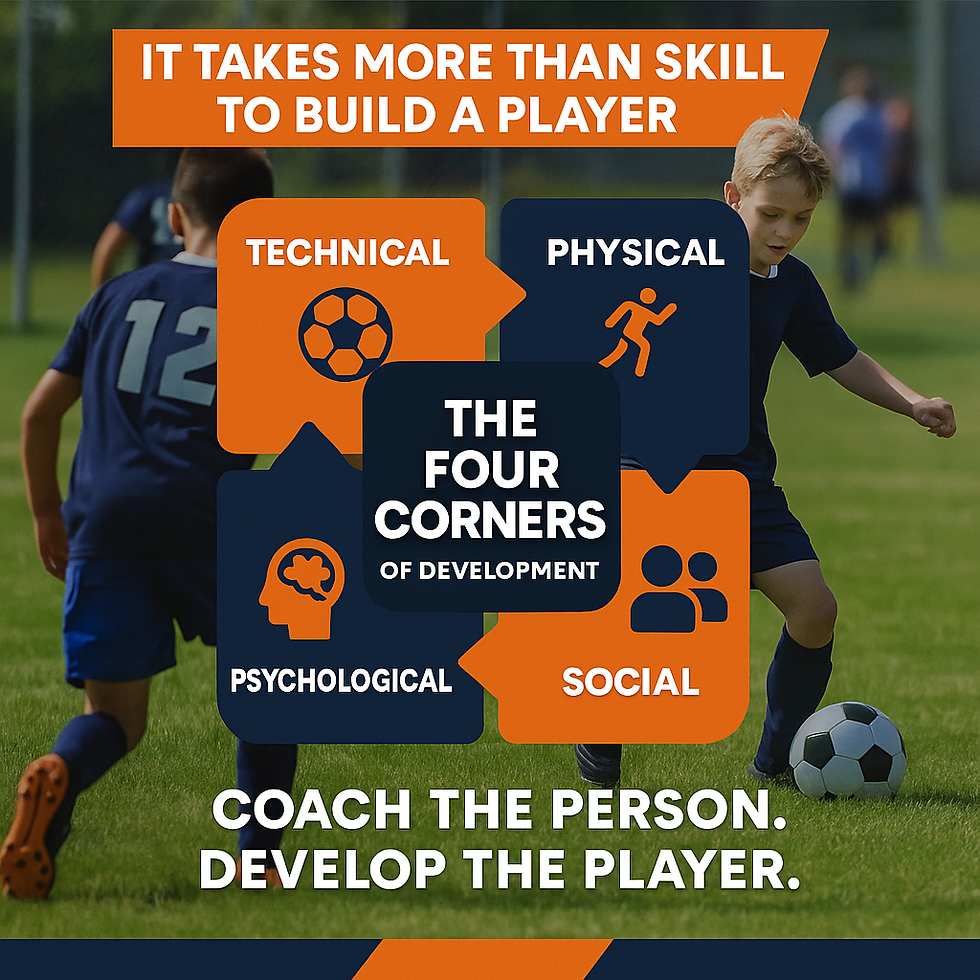Building a Game Day & Training Identity: Why Mental, Social, and Emotional Development Is the Missing Link
- Lindsay van Kessel

- Sep 2
- 4 min read

The Starting Point
When I first started coaching, I thought the biggest difference-makers were tactics, technique, and fitness. If a player could pass cleanly, execute patterns, and run for ninety minutes, I figured they’d succeed. Over time, though, I realized something that hit harder than any coaching course or drill design ever could: those things are fragile if the mental, social, and emotional foundations aren’t there.
I’ve watched talented players fold when pressure rose, kids with technical gifts stop playing altogether, and others thrive—not because they were “the best” at soccer, but because they had resilience, clarity, and a sense of identity.
That’s when I started to pay attention to what people like Dan Abrahams, Tracy Vaillancourt, Simon Sinek, and John Herdman were saying. And let me tell you: they weren’t just talking theory. They were describing exactly what I was seeing on the pitch every week.
The Mental Side (Dan Abrahams)
Confidence isn’t magic—it’s built. I’ve seen players who treat confidence like luck. If they’re “feeling it,” they play well; if not, they disappear. But the best young players learn routines and self-talk tools that let them show up regardless of nerves.
Scenario:
Player A is a technically sound striker but freezes on game day. In training, she hits corners for fun. On game day, she second-guesses, overthinks, and underperforms.
What she needed wasn’t more shooting drills. She needed a confidence routine: a first-touch plan, 3 cue words (“sharp, calm, ruthless”), and a reset phrase when she missed. That gave her anchors.
We need to stop saying “just be confident” and start helping players practice confidence like they practice passing.
The Social-Emotional Side (Tracy Vaillancourt)
Emotions, relationships, and belonging aren’t side notes in development—they’re central.
Scenario:
Player B is skilled but often withdrawn at practice. He avoids drills where mistakes might show, and teammates don’t pass to him much. After a while, his attendance drops.
The root problem isn’t his first touch—it’s his social-emotional growth. He doesn’t feel safe taking risks, doesn’t feel connected, and slowly drifts away.
I’ve seen players like this lost to the game because adults around them didn’t recognize the signs. A few small steps—checking in, creating supportive groupings, making “connection” part of training identity—could have saved their soccer journey.
The Why (Simon Sinek)
Too many players don’t know their why. They’re in soccer because it’s what they’ve always done, or because parents signed them up. Without a personal “why,” motivation crumbles.
Scenario:
Player C is gifted and loves the game but gets bored easily. Parents and coaches get frustrated because her effort swings wildly.
When asked, she shrugs: “I don’t know why I play.”
Once she connected her why—“I love competing, I love playing with friends, and I want to play for my high school”—training shifted. She wasn’t perfect, but she had direction. That’s the power of clarity.
The Identity (John Herdman)
A team without identity is just a group of players. A player without identity is inconsistent.
Scenario:
Player D is steady in training but disappears in tough matches.
What’s missing is an identity: Who am I when the whistle blows?
Herdman’s principle: set standards—effort, energy, execution—and live them. This player needed a game day identity that didn’t change under pressure.
What Coaches & Parents Can Do
Here’s the thing: none of this happens quickly. Early in my coaching career, I didn’t have the patience for it. I thought: If we just train harder, it’ll fix itself. Spoiler: it didn’t.
Over years of working with players, I’ve learned:
Identify who needs help. Look for players who avoid eye contact, get quiet after mistakes, or consistently underperform in games vs. training. They need confidence routines and emotional support more than another rondo.
Recognize who excels. Don’t assume your leaders are fine. The ones who perform consistently can still struggle with pressure, isolation, or burnout. Support them by encouraging reflection and giving them ownership of team culture.
Build skills as adults. Parents and coaches aren’t born knowing how to nurture this side. We need to learn it, model it, and practice it too. Asking the right reflection questions at dinner or after training can shift a player’s mindset massively.
Accept it’s not quick. Building identity takes time, setbacks, and repetition. Players will slip. That’s normal. The point isn’t instant results—it’s long-term growth. Development is non-linear, both in terms of physical and mental skills.
The Grumpy Soccer Angle
Too many youth setups treat mental and emotional development as fluff. It’s not fluff—it’s the foundation. If you want players to thrive, last, and love the game, you can’t skip this.
It’s messy. It takes patience. And it requires coaches and parents to stretch beyond drills and into real conversations. But if you stick with it, the payoff is massive:
Players who show up with purpose.
Players who bounce back from mistakes.
Players who stay in the game longer, because soccer isn’t just a sport—it’s a part of who they are.
That’s what building a game day and training identity really means. And trust me—I had to learn it the long way. Now, I wouldn’t coach without it.







Comments